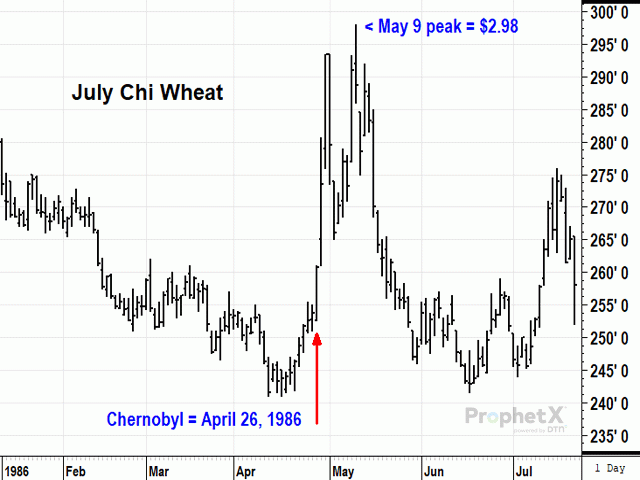No Analog to Today's Wheat Market
Chernobyl and Today's Wheat Markets Are Different Kinds of Nuclear
MT. JULIET, Tenn. (DTN) -- Talking about analogs in the digital era is strange, unless you're looking at markets or weather forecasts. Meteorologists at DTN often use analog years -- years with similarities to the current situation -- to help put weather conditions in context. Our grain analysts often do the same, but just like the weather, the comparisons are never perfect.
"It's difficult to recall any event that's as disruptive as this," DTN Lead Analyst Todd Hultman said about the war between Russia and Ukraine. "I think you'd have to go back to World War II to find another time that's this disruptive in the markets."
Even then, the U.S. grain markets relied more heavily on domestic supplies and less on global trade.
"Other options that have been tossed out are Chernobyl and the Cuban missile crisis," he said.
Hultman was a broker during the Chernobyl disaster, the world's worst nuclear accident, which happened in April 1986 when Ukraine was part of the former Soviet Union (USSR).
"I remember there was panic on the way up as prices reacted to the news, but what really surprised me was how quick the market collapsed after the event," Hultman said.
P[L1] D[0x0] M[300x250] OOP[F] ADUNIT[] T[]
Many traders believed the rally had legs. After all, it was unclear how far the radiation spread and what the impact would be on the surrounding cropland. But prices started trading lower after about two weeks and returned to their previous levels a month later.
"We weren't worried about grain supplies here in the U.S. because we had mountains of corn, and I'm sure wheat supplies were pretty healthy too," he said. USDA's World Agricultural Supply and Demand report from April 1986 shows that the USSR was expected to import 17 million metric tons that year, accounting for about a third of global imports.
Hultman said that report showed production and demand estimates, but no ending stocks estimate. "If only USDA would do the same with China today!" he added. (For more, please read "Why American Farmers Lose the Poker Game With China" here: https://www.dtnpf.com/….)
Today's wheat market is a different story.
Globally, supplies are the tightest they've been in nine years. Last year, the U.S. and Canada had their smallest crops in 19 years due to drought.
"Our U.S. wheat supplies were tighter than usual, so to have this kind of situation erupt in Ukraine is a much more bullish predicament than anything we saw in the Chernobyl days," Hultman said.
Ukraine produced 1.2 billion bushels of wheat last year and accounted for 12% of global exports, making it the world's fourth-largest supplier. Ninety-five percent of wheat grown in Ukraine is winter wheat, which means it's almost harvest season. While Russia is primarily attacking cities in this incursion, it's still unclear if Ukrainians will have the manpower, fuel or ability to harvest the crop. Ukraine also announced a ban on exports on Wednesday, so it's not going to be sending any abroad for the time being, removing a significant portion of global exportable supplies from the market.
Another difference is the involvement of noncommercial, or speculative, traders in the market.
CFTC has "increased the noncommercials' position limits through the years, and in the case of Chicago wheat, we recently had over 100,000 contracts on the short side of the market," Hultman said.
That contributed to five limit-up days, which were followed by a limit-down day on Wednesday. Hultman said that doesn't mean the rally has necessarily run its course, because Ukraine's prospects are so uncertain. U.S. growers are also dealing with drought conditions, casting even more concerns on global production. (For more, please read "Droughty Wheat Dilemma" here: https://www.dtnpf.com/….)
"How do you know when you're at the top of crazy? Nobody wants to think that it could get worse, but the thing is, it has been getting worse," Hultman said. "We are eons away from 1986."
Katie Dehlinger can be reached at Katie.Dehlinger@dtn.com
Follow her on Twitter at @KatieD_DTN
(c) Copyright 2022 DTN, LLC. All rights reserved.




